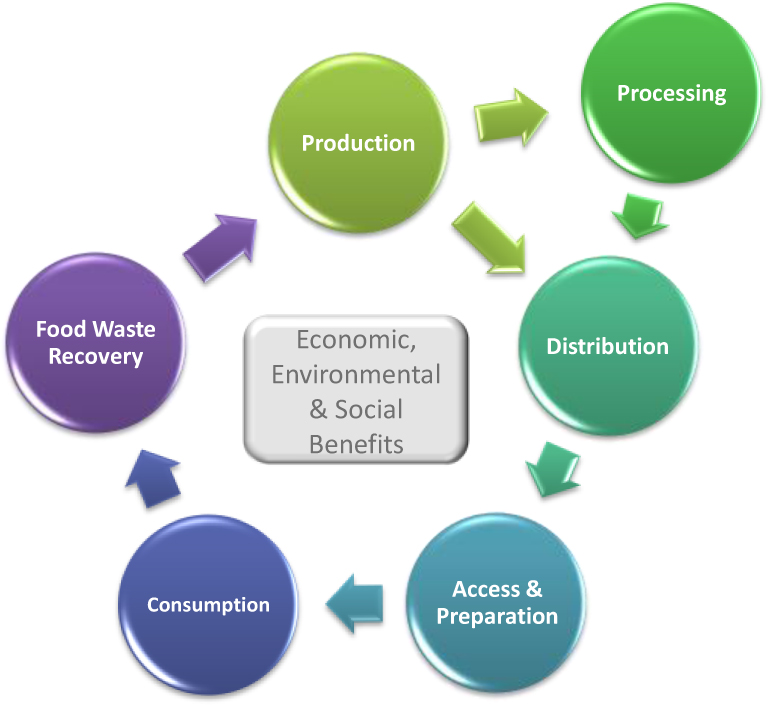Definition of a Sustainable Food System
A sustainable food system is a collaborative network that integrates several components in order to enhance a community’s environmental, economic and social well-being. It is built on principles that further the ecological, social, and economic values of a community and region. Characteristics of a sustainable food system are outlined below (based upon Pothukuchi, K. and Jufman, J.L., 1999):
A sustainable food system is one that:
- Is secure, and therefore reliable and resilient to change (including climate change, rising energy prices, etc) and accessible and affordable to all members of society;
- Is energy efficient;
- Is an economic generator for farmers, whole communities and regions;
- Is healthy and safe;
- Is environmentally beneficial or benign;
- Uses creative water reclamation and conservation strategies for agricultural irrigation;
- Balances food imports with local capacity;
- Adopts regionally-appropriate agricultural practices and crop choices;
- Works towards organic farming;
- Contributes to both community and ecological health;
- Builds soil quality and farmland through the recycling of organic waste;
- Supports multiple forms of urban as well as rural food production;
- Ensures that food processing facilities are available to farmers and processors;
- Is celebrated through community events, markets, restaurants, etc;
- Preserves biodiversity in agro-ecosystems as well as in the crop selection;
- Has a strong educational focus to create awareness of food and agricultural issues; and
- Is fairly traded by providing a fair wage to producers and processors locally and abroad.
The general components of a Sustainable Food System include:

A. Production
This refers to the planting, growing, raising and harvesting of food, including urban and rural agriculture.
B. Processing
This refers to the process of altering raw food stuffs to create a different, more refined product. Examples include preserving, cooking/baking, preparation, meat processing, grain milling and other value-adding operations at a variety of scales. All these changes require the use of energy and natural resources. Reasons for processing include the need to manage harvests, reduce waste, keep food safe and protect public health, improve palatability, feed large urban populations and feed rural and remote communities.
C. Distribution
This refers to the distribution and storage of both raw and processed food and the retailing, wholesaling and purchasing of food products. This takes place from farms to grocery stores, markets and restaurants. Energy and natural resources are used both in the packaging process and in the transport of both the food and the packaging materials to the places where packaging is completed.
D. Access & Preparation
This refers to the accessibility and affordability of food in addition to the preparation of both raw and processed food products. This takes place from the farm to grocery stores, to farmers markets, to communities and households. People purchase food based on family need, accessibility, food preferences, cultural background, religion, nutrition, values, attitudes and beliefs related to food and/or food advertising.
Their choices are made within certain constraints such as money available to buy food, time available to shop for food, time available to prepare and cook food, skill and confidence in food preparation and cooking, facilities available in the home and access to shops and transport, likes, dislikes, allergies and cultural factors. Choices are also limited by the food supply.
E. Consumption
This refers to the act of consumption and enjoyment of food. This can include food-related events and eating in both the public and private realms. Being able to select, prepare and cook minimally processed food from low in the food chain enables families to enjoy making healthy food choices, achieve good nutritional value for money, increase control over what they eat, understand where food comes from, begin to appreciate the important role of food producers in our society and contribute to protecting the environment. Preparing and sharing food also plays an important role in developing family and community relationships.
F. Food Waste Recovery
This refers to the diversion, management, and utilization of organic waste e.g. as an energy source and/or fertilizer using recycled nutrients. Recycling and reusing of food matter provides a valuable resource when considering food choices within the framework of the food cycle.

